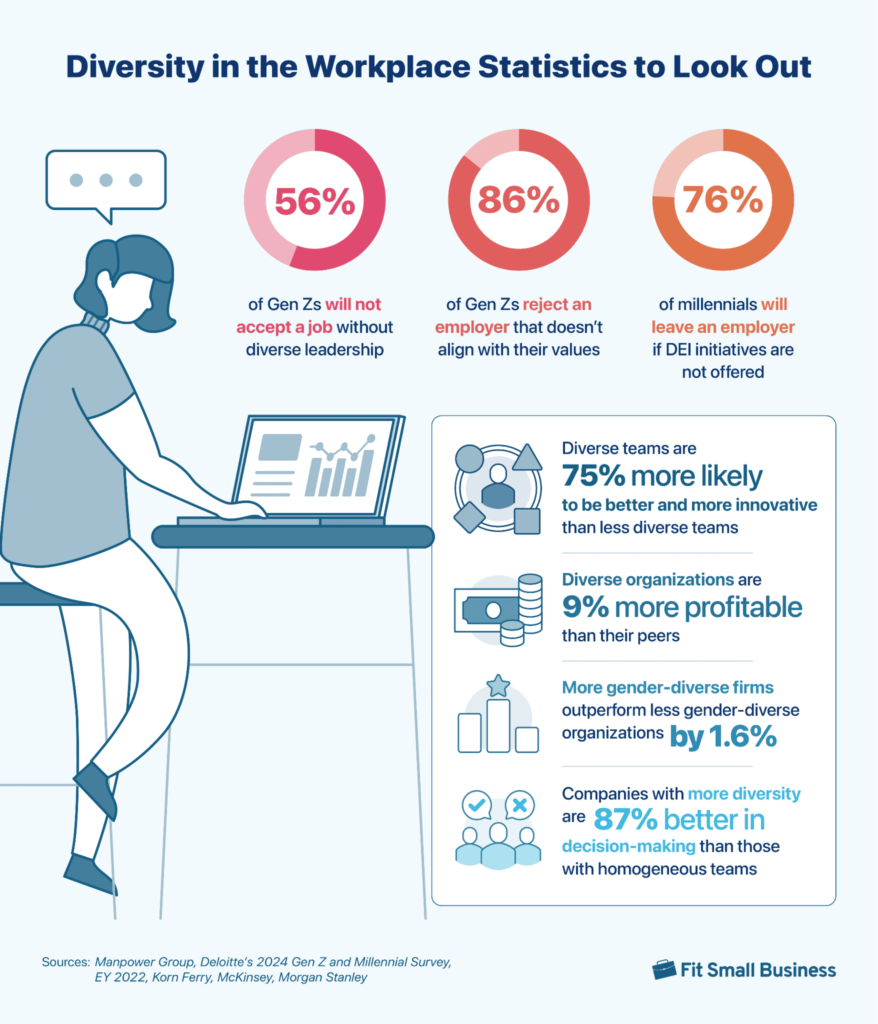Diversity in the workplace is more than just ticking boxes or meeting quotas for hiring people from specific demographic groups or using inclusive language. Genuine diversity, equity, and inclusion (DEI) involves creating an environment where all employees feel valued, respected, and empowered to contribute fully. When organizations embrace this, they unlock a wealth of benefits that affect every aspect of their business.

1. Enhanced Creativity & Innovation
Diversity boosts DEI in the workplace by bringing together individuals with different backgrounds, experiences, and perspectives. This diversity of thought can lead to breakthrough ideas and innovative solutions that might never have surfaced in a more homogeneous group.
Diverse teams are like the ultimate problem-solving machine. In fact, a recent research conducted by Korn Ferry said that the “collective intelligence of diverse teams” is 75% more likely to be better and innovative.
For example, a team working on a new app might benefit from having members who understand the needs of different user groups. A young tech expert might nail the interface design, while an older team member could provide insights into accessibility features that appeal to seniors. This could result in a product that resonates with a broader audience.
Remember when Apple introduced its Health app in 2014? It was a great idea but had one glaring omission—a period tracker. It turns out that the all-male development team simply did not think about it. Thus, teams cannot simply overlook the value of incorporating DEI into their company culture.
2. Improved Problem-solving
The diversity of thoughts and opinions delivers a variety of problem-solving approaches to the table, allowing for a more comprehensive analysis of a problem. Diversity also helps teams break free from groupthink, challenging assumptions and pushing teams to consider angles they might have missed.
For instance, a marketing team is tasked with launching a product globally. Team members from different cultural backgrounds can provide invaluable insights into how the product might be perceived in various markets, helping them avoid cultural blunders and tailor their approach for maximum impact. Furthermore, someone with a different professional background might question the entire marketing strategy, sparking a discussion that leads to a more robust plan.
3. Increased Employee Engagement & Retention
People thrive when they feel valued and represented. A diverse workplace where everyone feels they have a voice can significantly boost employee morale and job satisfaction. This is not merely about creating a pleasant work atmosphere; it’s about cultivating an environment where employees are empowered not only to contribute their best efforts and ideas but express themselves comfortably.
Imagine a working parent being able to openly discuss their childcare needs without fear of judgment or an employee from a different cultural background feeling empowered to propose an alternative approach to a project. When employees feel a sense of acceptance and belongingness, their engagement level and productivity increase.
An inclusive environment is imperative in promoting workplace retention. It enables employees to envision long-term career prospects within their organization. This is driven by their ability to see clear paths for advancement regardless of their background, gender, ethnicity, or other personal characteristics.
4. Broader Market Appeal
Having a workforce that reflects diversity isn’t just good for PR—it’s smart business. When your team mirrors the diversity of your market, you’re not just guessing what customers want; you’re tapping into firsthand insights. A deep understanding of your customers allows you to create offerings that resonate with them, encouraging them to try or patronize your products, which leads to higher revenues.
A great example can be seen in the cosmetics industry. For years, many brands offered a limited range of shades, which overlooked a large market segment. Then came Rihanna’s Fenty Beauty, offering 40 (now 50) shades of foundation. Within just 40 days, the singer’s beauty line generated $100 million in sales. This is what happens when companies understand and cater to a diverse market.
Then, there’s also the power of representation. When customers see themselves reflected in a brand—whether it’s in advertising, the product range, or customer service—they are more likely to trust the brand because they feel a connection to it.
5. Enhanced Company Reputation
In the past, a company’s reputation was all about product quality and customer service. Even though they still matter today, the game has changed. Today, consumers and job seekers also look at an organization’s values wherein diversity is a big part of the picture, especially for the younger generation.
According to a report from Manpower Group, 56% of Gen Zs would not accept a job without diverse leadership. Additionally, Deloitte’s 2024 Gen Z and Millennial Survey revealed that 86% of Gen Zs and 89% of millennials are willing to reject employers or assignments that don’t align with their values. That’s the majority of the emerging workforce (and consumer base) demanding diversity.
6. Improved Decision-making
In business, the quality of the management’s decisions can make or break an organization. And according to a Korn Ferry research, diverse-by-design teams make better decisions 87% of the time. That’s because diverse teams have:
- More comprehensive analysis of options: Each team member that comes from a different cultural background, for example, might identify potential issues in global markets. Thus, the decision is not just perceived from one angle but from a 360-degree view.
- Consideration of various viewpoints: It’s normal to have blind spots. In a diverse team, however, someone else’s perspective can point out that blind spot.
There’s also an added bonus to this. When decisions are made by diverse teams, there tends to be more buy-in across the organization. It’s easier to agree with a decision when you know it’s been examined from all angles.
Increased Profitability
Diversity is not just good for the company culture but also for its bottom line. McKinsey’s 2023 diversity study found that companies that are in the top quartile of ethnic and gender diversity are 9% more likely to outperform their peers in terms of profitability.
Take Alibaba, for example. It is one of the most gender-diverse leadership teams in the world, with 39% female executives. This move is paying off big time—women make up 70% of purchasing decisions on its platform. By having strong female representation in its leadership, it’s able to understand and cater to its primary customer base. It’s like having a direct line to your biggest market. Alibaba’s profitability does not end here. In 2020, despite the global pandemic, the company reported a 30% year-over-year revenue growth.
Effectively Promoting DEI in the Workplace
Here are a few steps on how to effectively promote DEI in your workplace:
- Start by getting buy-in from leadership and making DEI a core part of your business strategy, not just an HR initiative.
- Implement unconscious bias training, but don’t stop there—look at your hiring practices, promotion criteria, and company policies to identify and remove systemic barriers.
- Create employee resource groups to give underrepresented voices a platform.
- Set measurable goals and hold leaders accountable for progress. Remember, it’s an ongoing process, not a one-time fix.
- Be prepared to have uncomfortable conversations, listen to feedback, and adapt your approach as you learn.
- Most importantly, walk the talk—your actions, such as providing DEI training for your team, will speak louder than any diversity statement on your website.
Benefits of Diversity: Frequently Asked Questions (FAQs)
Diversity initiatives, while valuable, can bring their own set of challenges. Communication issues often arise as team members from different backgrounds may have varying communication styles or linguistic nuances, leading to misunderstandings or misinterpretations. This can slow down decision-making processes, as reaching an agreement might take longer when diverse perspectives need to be considered and reconciled.
Cultural misunderstandings are another hurdle; what’s considered polite or professional in one culture might be perceived differently in another, potentially causing friction or discomfort in the workplace.
Diversity’s impact on a company’s profitability is a cumulative effect of all the benefits discussed in the article. It can be summed up by the following:
- More innovation leads to better products and services
- Broader market appeal attracts a wider customer base
- Enhanced reputation draws in both customers and top talent
- Better decision-making reduces costly mistakes
- Increased employee engagement boosts productivity
It’s like a snowball effect where each diverse hire not only adds their individual contribution but also enhances the entire team’s performance.
Companies navigating workplace diversity need to be aware of a complex legal landscape. While federal laws like Title VII of the Civil Rights Act of 1964 prohibit discrimination based on protected characteristics, some states have recently passed laws restricting or banning certain types of diversity, equity, and inclusion (DEI) training.
At present, 40 anti-DEI bills[1] are being introduced targeting the workplace and higher education institutions. This creates a tricky balancing act for companies operating across multiple states, as they must comply with both anti-discrimination laws and these new restrictions on DEI initiatives. It’s crucial for businesses to stay informed about evolving legislation, consult with legal experts, and carefully design their diversity programs to avoid potential lawsuits while still fostering an inclusive workplace culture.
Reference:


